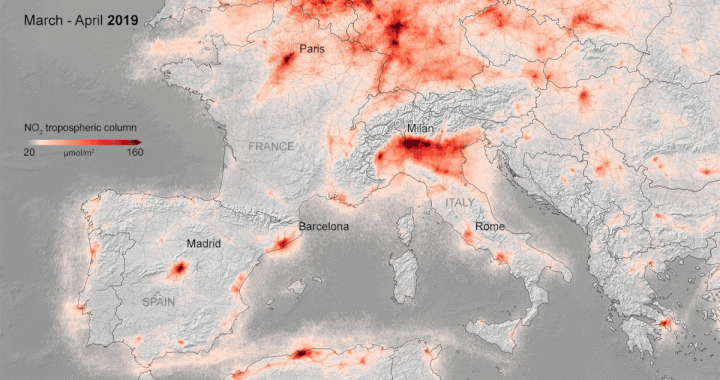Further analyses are showing the continued low levels of nitrogen dioxide concentrations across Europe – coinciding with lockdown measures implemented to stop the spread of the coronavirus. New data from the Copernicus Sentinel-5P satellite, from the European Union Copernicus programme, show some cities seeing levels fall by 45—50% compared to the same period last year.
Scientists from the Royal Netherlands Meteorological Institute (KNMI) have been monitoring air pollution over Europe in the past months using data from the Tropomi instrument from the Copernicus Sentinel-5P satellite.
The new images show the nitrogen dioxide concentrations from 13 March until 13 April 2020, compared to the March-April averaged concentrations from 2019. Madrid, Milan and Rome saw decreases of around 45%, while Paris saw a dramatic drop of 54% – coinciding with the strict quarantine measures implemented across Europe.

Nitrogen dioxide is produced from power plants, vehicles and other industrial facilities and can have significant impacts on human health – increasing the likelihood of developing respiratory problems. Nitrogen dioxide concentrations in our atmosphere vary widely day to day owing to the fluctuations of emissions, as well as variations in weather conditions.
This weather-induced variability proves difficult to draw conclusions based only on daily or weekly measurements, making it necessary to analyse data over a substantial period of time to iron out any anomalies.
Henk Eskes, from the Royal Netherlands Meteorological Institute (KNMI), comments, “There are considerable variations of weather in every country from one day to the next, creating a large impact on the dispersion of nitrogen dioxide.
“Averaging data over longer periods of time allows us to see clearer changes in concentrations owing to human activity. For this reason, the maps show concentrations over a monthly period and are provided with an uncertainty of 15% which reflects weather variability not accounted for in the monthly averages used.”
As lockdown measures will continue in the following weeks, the KNMI team will continue to work on a more detailed analysis of other countries in northern Europe, where a larger variability in data owing to changing weather conditions is observed.
Making use of air-quality models, such as the Copernicus Atmosphere Monitoring Service, as well as combining results from in situ data, will narrow down the impact of changes in weather on air pollution estimates.



